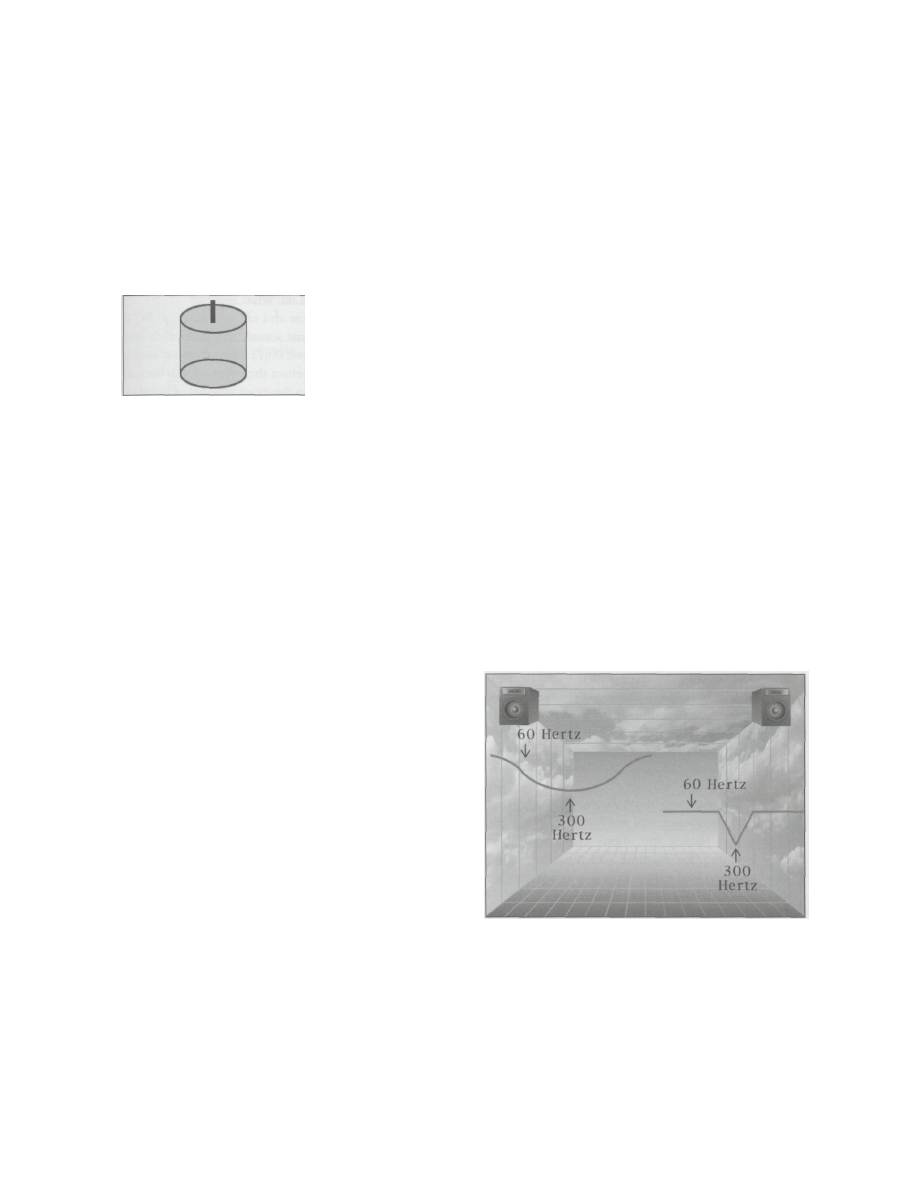ВУЗ: Казахская Национальная Академия Искусств им. Т. Жургенова
Категория: Книга
Дисциплина: Не указана
Добавлен: 03.02.2019
Просмотров: 7994
Скачиваний: 204
056.png)
Equalizing in the Mix When Recording Onto the
Multitrack
The next time to check the EQ of each sound is when
the entire band starts rehearsing the song. At this
point, you want to check the EQ of each instrument
relative to every other instrument in the mix. You can
make sounds more similar to each other or more dis-
similar. You can make a lead instrument more cutting
and abrasive, to really grab attention. You can give
extra bass to a particular instrument to make the song
more danceable or to excite the listener.
To make the process a bit easier, follow this pro-
cedure: First, scan the high frequencies and check
the relative brightness of all the sounds in the song.
Make sure all of them are as bright as you want them.
They should have a similar amount of brightness, but
sometimes you might want some sounds to be
brighter or duller than others.
Visual 77. Song With High Frequencies Highlighted
Second, scan the midrange frequencies, check-
ing for the relative volume of these frequencies across
all the instruments. Midrange frequencies seem to
stick out when boosted too much. Make sure that all
instruments have the exact amount of midrange fre-
quencies that you want. The sounds might have a sim-
ilar amount of midrange frequencies, but sometimes
you may want some sounds to stick out more so they
grab your attention.
Visual 78. Song With Midrange Frequencies
Highlighted
Third, scan the bass frequencies, checking for
the relative volume of bass in each sound in the bass
range. For example, check the relative amount of
bass frequencies present in the kick drum compared
to the bass guitar. Listen and make sure that it is the
way you want it to be. This frequency range is the one
most commonly missed when mixing an album or
project.
Visual 79. Song With Low Frequencies Highlighted
41
Chapter Four

It is critical that you check the relative EQ of
each instrument in the mix at each frequency range.
The amount of time you spend doing this often
depends on the band. Some bands expect to be
recording within a few hours of the time they arrive
and have very little patience (or money). Other
bands spend weeks getting the right sound and EQ
before recording to the multitrack. It is a good idea
to set up the band the day before the session, get all
the sounds EQ'd, get a headphone mix, then go
home. The next day everything is set to go and every-
one is fresh.
It is also a good idea to talk with the band
beforehand and let them know that you will be spend-
ing a good amount of time working on the sounds at
the beginning of the session. If the band knows what
is going to happen, they won't get frustrated while
waiting to actually begin recording. They should
appreciate the fact that you want it to sound as good
as possible.
Equalizing in Solo During Mixdown
When you go to mixdown a song, the first step is to
EQ each of the sounds individually. If you did your
job well during the recording session (that is, if you
had time), you might have little or no EQ'ing to do.
"If it ain't broke, don't fix it." However, often you will
need to EQ the sound again because you know what
the band is going for and you have a new perspective
—a fresh ear. You also have a major advantage that
you didn't have when you began the recording ses-
sion: You know what the whole song sounds like with
all of the instruments playing together. Now you can
set the EQ of each sound with the final mix in mind.
People often wonder why things don't seem to
sound the same when you come back to do the mix-
down. First, when using analog tape (as opposed to
digital), you lose highs every time the tape is played
back on the multitrack. After a couple of weeks of
overdubs, the highs are dampened drastically.
Second, it is easy to think that you have some-
thing sounding right simply because you have made it
sound so much better. When a band first comes in,
often you listen to the sounds (and how bad they
might sound), then you EQ them and you're happy
because you've made the sound great compared to
the original sound. The problem is that you should
be EQ'ing the sound based on the real world sound
of current CDs. You might have made it sound light
years better, but it needed more EQ'ing . . . to sound
like a CD. When you come back in to mix the song
down, you have been listening to the radio or CDs in
the real world. When you put on the multitrack, you
automatically compare your recording to the real
world and realize it didn't sound as good as you
thought when you did the recording session.
Also, especially with less expensive mixers, you
don't have enough bands of EQ so you can't do all of
the equalization required while recording the band.
In this case, the EQ must be completed during mix-
down. This is often the case when you don't have a
full parametric EQ.
Equalizing in the Mix During Mixdown
The way the EQ sounds in the mix during the mix-
down is the true test. Again, you should check all the
sounds relative to each other at each frequency
range: highs, midranges, and lows. If it is already
pretty good, you can now work on fine-tuning the rel-
ative EQs. This is where you do the magical stuff. For
example, you might add a tiny bit of 12,000Hz on
some of the high-frequency sounds to make the over-
all mix sparkle. Or you might consider making a gui-
tar solo track a little brighter and edgier, so that it
grabs your attention.
At this point, you might actually turn the EQ
knobs while the song is playing. Perhaps you might
EQ an instrument differently for various sections of
the song. Or, to really flip people out, you could
change the EQin the middle of a section of a song. It
is also interesting to EQa sound so that it seems to be
coming out of a telephone.
Equalizing the Entire Mix During Mastering
There are two main types of EQ done during master-
ing. First, minor repairs can be done if the overall EQ
doesn't sound quite right, but if the problem is very
bad the entire song must be remixed. It is quite com-
mon to adjust the amount of overall bass or treble
slightly. Second, the overall EQ can be adjusted to
make the overall bass, midrange, and treble more
similar from song to song. Again, if the difference is
too great, it might require remixing the songs. There
is only so much that can be done in mastering with
EQ since all the sounds are no longer separate on
their own tracks.
USING AN EQUALIZER: STEP-BY-STEP
INSTRUCTIONS
When you approach a mixing board equalizer for the
first time, it is a good idea to play with it to get to
know how it works and what it does. However, when
working on a project with other people, you must be
quick at getting things to sound great. The following
procedure will help you become more efficient
whenever you use an equalizer.
42
The Art of Mixing

A COMMON, STEP-BY-STEP PROCESS FOR
EQ'ING A SOUND
1. Reset to "0"
Reset the volume controls on the equalizer to "0."
This usually means setting the volume knob
straight up (not all the way counterclockwise). At
this position you are neither boosting nor cutting
the volume of any frequency.
Visual 80. EQ Knob
With Volume Set
to "0"
Even if the EQ has an on/off switch, the volume
knob should still be set to "0," so when the EQ is
turned on, it makes no changes and you are start-
ing from "0," not some unknown preset. In many
professional studios, if you don't reset, or normal,
the EQ at the end of your session, you will hear
from the management later.
2. Listen
The most common mistake made by an inexperi-
enced engineer is to begin turning the EQ knobs
before listening. Don't touch the knobs until you
know what you want to do. Listen to see if anything
is wrong with the sound first, and if it ain't broke,
don't fix it.
There are many fine details you should listen for
when EQ'ing. The three main things to check are
if the sound is muddy, has irritating or "honky" fre-
quencies in the midrange, or is bright enough. If
you do nothing else while recording to the multi-
track, you should at least take care of each of these
aspects, which make up over 75% of all EQ'ing to
be done.
a) Cut Muddiness (100-800Hz): Check each in-
strument for muddiness. Kick drums almost always
need to have the muddiness cut (unless it is a rap
or hip hop kick). Other potentially muddy instru-
ments include toms, bass guitar, piano, acoustic
guitar, and harp. Muddiness is normally around
300Hz. If you cut the muddiness too much, the
instrument will sound thin because this mud also
contributes to the body of most sounds. When cut-
ting muddy frequencies, always make sure that you
haven't lost your bottom: the low lows. You might
compensate by boosting the lows around 40-60Hz.
Using a parametric to zone in on the specific
muddy frequency will help to preserve the bottom
of the overall sound.
b) Cut Irritation (1000-5000Hz): Cut any exces-
sively irritating or honky frequencies occurring in
the midrange from 1000-5000Hz. Vocals, electric
guitars, and cymbals (including hi-hat) often need
frequencies cut in the midrange. Depending on
the type of music (and the particular snare drum
used), snares sometimes need this edge cut also.
The best way to detect an irritating frequency is to
turn the entire sound up very loud. If you and the
people in the room are cringing on the floor, then
it's irritating. Never boost or cut the midrange too
much and make sure you haven't made the sound
too dull. At that point, you might compensate by
boosting the highs around 5000-8000Hz. Using a
parametric to zone in on the specific irritating fre-
quency will help to preserve the brightness of the
overall sound.
c) Boost Highs (5000-8000Hz): Boosting highs
on instruments that sound dull, like the snare, is
largely dependent on the style of music. R&B,
dance, and certain types of rock 'n' roll require
more crispness than other styles. Country, middle-
of-the-road, and folk music do not need as much
boost in this range, so they sound more natural.
3. Set the Bandwidth
a) When getting rid of muddy frequencies, set
the bandwidth as thin as possible, because if you
use a wide bandwidth, you might also drop the nice
"bottom."
Visual 81. Wide and Thin Bandwidths on 300Hz Cut
b) When getting rid of irritating frequencies, set
the bandwidth as thin as possible for very much the
same reason as above. If you use a wide bandwidth
on a vocal, guitar, or cymbal, you might lose the
entire body of the sound in the midrange. Then
the sound would be dull and not present.
c) When boosting highs, set the bandwidth to
medium wide. This sounds more natural. If ever in
doubt as to how to set the bandwidth, start with the
43
Chapter Four

thinnest one possible. Then you can try widening it
out a bit to see if it does what you want and sounds
better. By doing this, you end up with the center
frequency where it should be.
4. Find the Frequency to be Boosted or Cut
Now that you have decided that a frequency needs
to be boosted or cut, you must first find the fre-
quency.
a) Boost the volume on the band of EQ where
you think the problem is. When first starting out, it
is a good idea to boost the volume all the way. Be
careful, though. Boosting the volume all the way in
the bass area can blow up your speakers. And
boosting the volume all the way in the midrange
can make you deaf. It's a good idea to keep your
other hand on the channel fader or master volume
control so as not to hurt anybody.
Boosting the volume all the way will help you
locate the frequency you want to turn up or down.
A good analogy is when you cook with new spices.
Though tasting red hot chili peppers by themselves
can be a bit extreme, you need to taste them before
cooking with them to get an idea of what they taste
like. Similarly, when you boost the EQ volume all
the way, though it won't be that strong in the mix,
it gives you an idea of what it might be like when
added in moderation.
NOTE: You can also cut the volume all the way
instead of boosting the volume all the way. Doing it
this way is a little less annoying, because you are
looking for "good" sounds instead of irritating or
muddy sounds. However, you run the risk of not
finding the exact frequency that was the problem
in the first place.
b) When sweeping the frequency knob to find
the culprit frequency, you are looking for the fre-
quency that sounds the worst—the muddiest or
most irritating, for example. On the other hand,
when trying to find a frequency to turn up, you are
looking for where it sounds the best.
If you are trying to get rid of a frequency and
you have cut the volume knob all the way (instead
of having boosted the volume knob all the way),
sweep the frequency knob to find the spot where
the sound seems to be the best.
5. Return the Volume Knob to "0"
With the volume boosted all the way, you are now
in outer space. You have lost all touch with the real-
ity of what the sound was like in the first place.
Regain your perspective on the tone of the sound
before it was EQ'd by returning the volume knob
to "0" (on the EQ band you are working on).
6. Boost or Cut the Volume to Taste
If you are getting rid of a frequency, slowly turn the
volume down as much as you think it needs. If you
are boosting a frequency, same thing. Play with the
volume knob until you figure out how much it
needs to be boosted.
7. Check to See If You Like What You Did
Turn the EQ switch on and off, compare the EQ'd
sound with the original sound, and make sure you
like what you did. If you don't have an on/off switch
on your EQ quickly return the volume knob back to
"0," then zip it back to the exact amount of boost or
cut. This is also helpful when doing more than one
EQ change on a sound. For example, say you have
cut the muddiness on one band and you have
brightened the highs on another band. If you turn
off the EQ you turn off both bands. Instead, simply
return the volume control to "0" on the one EQ
band you are working on, so you can see what that
one change is doing and whether you like it or not.
So far I have provided you with an extensive
overview of how to use EQ. However, it requires
practical experience to get know its intricacies. For
those of you who are just beginning, here is a list-
ing of common EQ techniques for well-known
instruments—although, in reality, every sound is
different.
44
The Art of Mixing
060.png)
Chart 4. Equalization Chart
Chart 5. Common Quick General EQ
45
Chapter Four